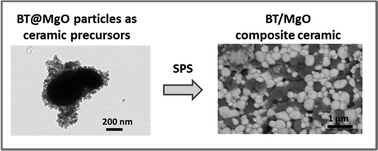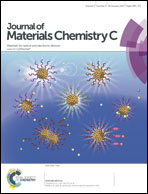From core–shell BaTiO3@MgO to nanostructured low dielectric loss ceramics by spark plasma sintering†
Abstract
We report a quite general way to design materials with tailored properties by combining thermolysis and fast sintering approaches. Submicrometric-sized BaTiO3 particles have been directly coated in a continuous nanocrystalline MgO shell through a thermal decomposition process. The electron microscopy study has evidenced a shell composed of randomly oriented MgO nanocrystallites. The final nanostructured composite, made of sub-micrometric MgO and BaTiO3 grains uniformly distributed, is obtained in situ during the SPS process. Such a rearrangement can be explained by the initial core–shell architecture, the weak cohesion of the MgO nanocrystallites and their soft plastic behavior under SPS conditions. The composite effect leads to significant modifications in both the dielectric properties and Curie–Weiss parameters compared to uncoated BaTiO3, especially a decrease and thermal stabilization of both the permittivity and the dielectric losses. We ascribe such changes to the stress generated during SPS through the extended interfaces between the two components.


 Please wait while we load your content...
Please wait while we load your content...